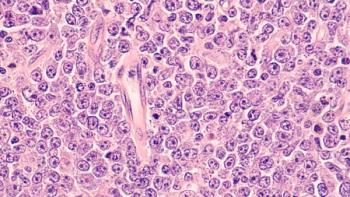
Belantamab Mafodotin Combo Extends PFS vs Daratumumab in Multiple Myeloma
These data may support belantamab mafodotin, bortezomib, and dexamethasone as a new standard of care for patients with relapsed/refractory multiple myeloma.
Belantamab mafodotin (Belamaf), bortezomib, and dexamethasone (BVd) for the treatment of relapsed/refractory multiple myeloma improved median progression-free survival (PFS) by 23.2 months vs daratumumab (Darzalex), bortezomib, and dexamethasone (DVd), according to findings presented at the 2024 ASCO Annual Meeting and simultaneously published in The New England Journal of Medicine.1,2
The median PFS with BVd was 36.6 months compared with 13.4 months for DVd, representing a 59% reduction in the risk of progression or death (HR, 0.41; 95% CI, 0.31-0.53; P <.001). Data for overall survival (OS) were 29% mature at the time of the analysis, and median figures were not yet available. At 18 months, 84% of patients remained alive in the BVd group compared with 73% in the DVd arm, indicating an early, but not yet statistically significant, reduction of 43% in the risk of death (HR, 0.57; 95% CI, 0.40-0.80).
"There was a statistically significant and clinically meaningful progression-free survival benefit, with a strong and clinically meaningful overall survival benefit favoring BVd over DVd. All the response as well as the different response categories were also in favor of BVd," lead investigator María-Victoria Mateos, MD, PhD, Hospital Universitario de Salamanca, Instituto de Investigación Biomédica de Salamanca (IBSAL), Centro de Investigación del Cáncer (IBMCC-USAL, CSIC), said during a presentation of the results. "These trials support the potential for BVd as a potential new standard of care for relapsed/refractory myeloma patients."
In the study, 494 patients were randomized to receive BVd (n = 243) or DVd (n = 251). In the investigational arm, intravenous belantamab mafodotin was administered at 2.5 mg/kg every 3 weeks. In the control arm, daratumumab was administered at 16 mg/kg in a 21-day cycle that started as weekly in cycle 1 to 3, every 3 weeks in cycles 4 to 8, and every 4 weeks for cycle 9 and beyond. In both groups, bortezomib was administered at 1.3 mg/m2 on day 1, 4, 8, and 11 of a 21-day cycle for up to 8 cycles in both groups and dexamethasone was given at 20 mg daily.
The median age of patients in the investigational arm was 65.0 years and was 64.0 years in the control arm. The ECOG performance score was 1 or less for 96% of patients, and most had R-ISS stage I or II disease (95%). The median time from diagnosis in the BVd arm was 4.3 years compared with 3.9 years in the control group. Two-thirds of patients had standard cytogenetic risk (72% and 70% in the investigational and control arms, respectively). The most common high-risk cytogenetic characteristics was t(4;14), which was present in 17% of participants. This was followed by a deletion in 17p13 for 12% in the BVd group and for 14% in the DVd arm.
Extramedullary disease was present for 5% of those in the BVd arm compared with 10% of those in the DVd group. Half of patients had received 1 prior line of therapy, and 12% in the BVd arm and 11% in the DVd group had received 4 or more lines of therapy. Prior therapies were similar between groups and the time to relapse after the most recent therapy was the same for each group, with 20% having relapsed in 12 or less months. There were 2% of patents in the DVd arm who had received prior daratumumab. Rates of prior chemotherapy and autologous stem cell transplantation were similar.
In a pre-specified subgroup analysis, Mateos noted that BVd was superior to DVd across all subgroups, including those with disease refractory to prior lenalidomide (Revlimid) and those with high-risk cytogenetics. The hazard ratio for those refractory to lenalidomide was 0.37 (95% CI, 0.24-0.56) favoring BVd. For those not refractory to the immunomodulatory drug, the HR was 0.48 favoring BVd (95% CI, 0.34-0.67). In those with high-risk cytogenetics, the HR was 0.36 in favor of BVd (95% CI, 0.22-0.58) and those with standard risk, the HR was 0.48 (95% CI, 0.35-0.65).
Deeper responses were noted with BVd vs DVd, Mateos noted. The objective response rate (ORR) with BVd was 82.7%, which consisted of a stringent complete response (sCR) rate of 14% and a complete response (CR) rate of 20.6%, for a CR or better rate of 34.6%. The CR or better rate with DVd was 17.1% and consisted of a sCR rate of 5.2% and a CR rate of 12%. The ORR in the DVd arm was 71.3%. Minimal residual disease (MRD)-negative (10-5 sensitivity) CRs were experienced by 24.7% of those in the BVd arm vs 9.6% in the DVd arm. Very good partial responses were seen in 31.3% of those treated with BVd and for 29.1% of those treated with DVd. MRD-negative VGPR or better rates were 38.7% and 17.1% for BVd and DVd, respectively.
"The CR rate or better was doubled with BVd and it is important to note the superiority of MRD negativity rate, which in myeloma is one of the most important factors predicting outcome," Mateos said.
An adverse event (AE) of any grade was experienced by all patients enrolled in the trial. Grade 3/4 AEs that were related to treatment occurred in 90% of those enrolled in the BVd arm compared with 67% in the DVd group. AEs led to treatment discontinuation for 31% of patients in the BVd arm compared with 19% in the DVd group. AEs led to a dose reduction for 75% of patients in the BVd group compared with 59% in the DVd group. Treatment-related serious AEs were seen in 19% of those in the BVd group and for 12% in the DVd group. Fatal serious AEs related to study drug were experienced by 7 patients in the BVd arm compared with 2 in the DVd arm.
A further analysis of AEs was conducted to adjust for differences in exposure time (exposure duration was 15.9 months for BVd vs 12.9 months for DVd). Per 100 person years, the rate of grade 3/4 AEs was 68.8% with BVd compared with 62.4% for DVd. The rate of serious AEs per 100 person years was 36.3% vs 30.0% for BVd and DVd, respectively.
Changes in baseline correct visual acuity were the most unique AE, Mateos noted. Overall, 34% of patients experienced a worsening in visual acuity from 20/20 to 20/50, or blurred vision, Mateos said. There were 2% of patients who experienced a shift to 20/200 vision, or impaired vision. "With dose adjustments and delays, a majority of patients resolved these ocular events, and only 9% of patients had to discontinue treatment due to ocular events," said Mateos.
An analysis was conducted to examine whether dose interruptions and delays impacted PFS. For those with 1 or more dose delays that lasted 12 weeks or longer, the median PFS was 36.6 months, which matched the overall median for the trial. Moreover, quality was not different between groups, Mateos noted.
References
- Mateos M-V, Robak P, Hus M, et al. DREAMM-7 update: Subgroup analyses from a phase 3 trial of belantamab mafodotin (belamaf) + bortezomib and dexamethasone (BVd) vs daratumumab, bortezomib, and dexamethasone (DVd) in relapsed/refractory multiple myeloma (RRMM). J Clin Oncol. 2024;42 (suppl 16):7503. Doi:10.1200/JCO.2024.42.16_suppl.7503.
- Hungria V, Robak P, Hus M, et al. Belantamab Mafodotin, Bortezomib, and Dexamethasone for Multiple Myeloma. N Engl J Med. 2024. Doi: 10.1056/NEJMoa2405090


















































































